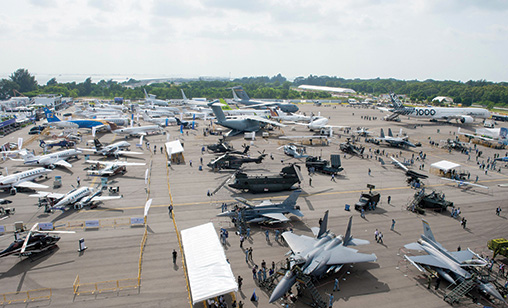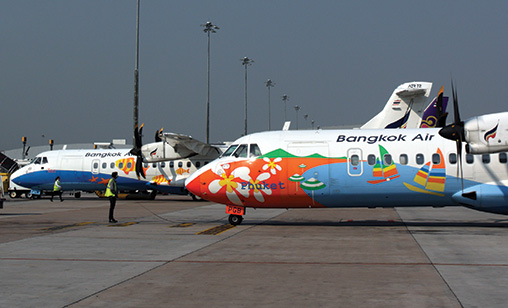News Backgrounder
Digital innovation centre stage at Singapore Airshow
Global original equipment and service companies chose February’s Singapore Airshow to showcase their new focus on digital MRO, artificial intelligence and investment in training, technology and manufacturing.
March 1st 2018
It was not surprising the closing press conference at the region’s biggest show, in Singapore in February, was cancelled. Read More »
“Companies are becoming confidential on transaction values and the number we have will not be meaningful,” said the show’s managing director, Leck Chet Lam.
 |
He was right. With none of the big aircraft manufacturers announcing any sales of commercial jets, the only announcements were from Bangkok Airways for four ATR 72-600 turboprops, at list prices of $100 million, and an $80 million sale of a Honda business to European air taxi operator, Wijet.
Of more significance, considering demand for pilots in the Asia-Pacific, was the $74 million purchase by Chinese Flight Training specialist, Fanmei Aviation Technologies, of 152 Piper Aircraft training planes. It was the biggest order in the history of the U.S. company.
Fanmei president, Don Li, said the new aircraft will be a “key element” in China’s general aviation roadmap as the country’s commercial passenger market expands. Piper President and chief executive, Simon Caldecott, complimented Fanmei for “establishing a prestigious pilot development program to meet the growing need for exceptionally trained airline flight crews”, adding that the synergy was a “wonderful opportunity for both organizations as we work collectively to help address the global pilot shortage”.
At the last Singapore Airshow in February 2016, deals valued at $12.7 billion were signed with airlines and suppliers. At the 2014 show, purchases committed hit $32 million. But this year, show analysts said, many full service and low-cost Asia-Pacific carriers had placed large orders for jets over the last five years. Airbus and Boeing in particular have record backlogs of aircraft orders.
Airbus estimates more than 14,000 aircraft, including freighters, are required in Asia to 2036, some 42% of world demand. But airlines are being cautious. They fear overcapacity. Endau Analytics’ Shukor Yusof added that weak profitability was to blame for the declining appetite for more new planes at the region’s airlines. “Although the traffic numbers in Asia point to huge growth, the reality is that profit margins are thin. It’s harder to make money,” he said.
| Singapore government invests US$47 million in university aerospace research The Civil Aviation Authority of Singapore (CAAS) announced during the Singapore Airshow that it would extend its collaboration with Singapore’s Nanyang Technological University for another five years by investing up to US$47 million in artificial intelligence and data science research. In the next five years, the partners will conduct research into air traffic management solutions in five areas: Artificial Intelligence (AI) and Data Science; Urban Aerial Transport Traffic Management and Systems; Regional Air Traffic Management Modernization and Exploratory Studies of Emerging Technologies and Talent Development, with a focus on innovation. |
The real action in Singapore this year was among the sales teams for MROs and tracking and communications systems, particularly Air Traffic Management systems that are designed to manage the largest aircraft market in the world.
During the show week, the International Air Transport Association (IATA) and the Civil Aviation Authority of Singapore (CAAS) signed a Memorandum of Collaboration (MoC) to establish a Global Safety Predictive Analytics Research Center (SPARC) in Singapore. The MoC was signed by IATA director general and CEO, Alexandre de Juniac, and the director general of CAAS, Kevin Shum.
SPARC will utilize predictive analytics to identify potential aviation safety hazards and assess related risks by leveraging the research capabilities in Singapore, and operational flight data and safety information available under IATA’s Global Aviation Data Management (GADM) initiative.
End users across the aviation community can work collaboratively at the system level to address and implement appropriate safety measures to mitigate risks or prevent the occurrences of safety hazards. The first area of focus for SPARC will be runway safety, such as runway excursions, which are the most frequent category of accidents in recent years, IATA analysis has revealed.
“The accident investigation process will continue to be a fundamental tool in improving safety. However, as the number of accidents declines, we need to take a system-based, data-driven, predictive approach to preventing accidents, including analyzing the more than 10,000 flights that operate safely every day. The Singapore Government and the CAAS have been strong partners of IATA and we look forward to working with them through SPARC to help to take aviation safety to an even higher level,” said de Juniac.
Shum said the establishment of SPARC in Singapore is especially timely given the anticipated doubling of air traffic in the Asia-Pacific by 2036. “SPARC’s predictive data analytics capabilities will help the aviation sector in Asia-Pacific and better anticipate, prioritize and address safety issues more effectively,” he said.
 |
In the MRO sector, there was more evidence that original equipment manufacturers (OEMs) such as Boeing and Airbus are continuing to make inroads into the aftermarket sector. With forecasts that the Asia-Pacific MRO market will be worth $22.7 billion annually by 2027, that is hardly surprising.
At Singapore, Boeing signed nearly $1 billion in new service deals, including with Singapore Airlines to use Boeing’s Electronic Logbook on its B777 and B787 fleets, a landing gear exchanges contract with Japan’s All Nippon Airways and a partnership with China Southern Airlines and Guangzhou Aircraft Maintenance Engineering Company to develop services for the Boeing Global Services (BGS) program.
Airbus, which is reporting double digit growth in its Services By Airbus aftermarket division, announced the establishment of a new customer services center at its Airbus Asia headquarters at Singapore’s Seletar Aerospace Park. The center adds to its existing regional presence, which includes Malaysia-based acquisition, Sepang Aircraft Engineering, and its Heavy Maintenance Services Singapore joint venture with SIA Engineering.
Singapore Airlines MRO arm, SIA Engineering, was also busy. It finalized a joint venture with GE Aviation for GE90 and GE9X overhauls, following an initial announcement of the initiative at the 2017 Paris Air Show.
GE Aviation also announced plans to build a facility to manufacture GE9X engine parts in Singapore, growing its presence in the components segment, which accounts for the largest MRO market in the region in 2018, at 33%.
Pratt & Whitney, through its Pratt & Whitney Eagle Services Asia business, expanded its offering in Singapore by launching full services for the Engine Alliance GP7200 that powers A380 aircraft. The U.S. subsidiary, which previously carried out low pressure compressor module overhauls on the engine, plans to conduct its first full service on the widebody engine this year.
Britain’s Rolls-Royce chose Singapore to showcase its IntelligentEngine strategy, which will change the process of its design, manufacturing and servicing of its engines. “We see it as being almost as big a shift as it was to move from the piston to the gas turbine. It’s almost a new way of thinking,” Rolls-Royce’s marketing senior vice president, Richard Goodhead, said.
| Singapore broadens FAA cooperation In early February, the Civil Aviation Authority of Singapore (CAAS) said it would deepen its co-operation with the U.S. Federal Aviation Administration (FAA) by signing revisions to the Bilateral Aviation Safety Agreement – Implementation Procedures for Airworthiness (BASA-IPA) on the sidelines of the Singapore Airshow. The enhancements follow the launch of the U.S. – Singapore Joint Aviation Steering Committee (JASC) in December 2017. Co-led by the FAA Administrator and the CAAS Director-General of Civil Aviation, JASC manages and strategically guides technical collaboration of aviation initiatives between the two bodies. Areas of focus are international aviation safety, regional cooperation and development, air traffic management, environment, and cybersecurity. The revisions to the BASA-IPA simplify and remove some issues for achieving airworthiness approvals and they will save airlines money. “The removal of the limitations will now allow airlines to undertake a comprehensive supplemental type certificate package of modifications for cabin, mechanical and electrical systems, as well as the in-flight entertainment system. This will certainly help airlines reduce lead times and costs of cabin retrofit programs,” said Singapore Airlines senior vice president engineering, Lau Hwa Peng. |